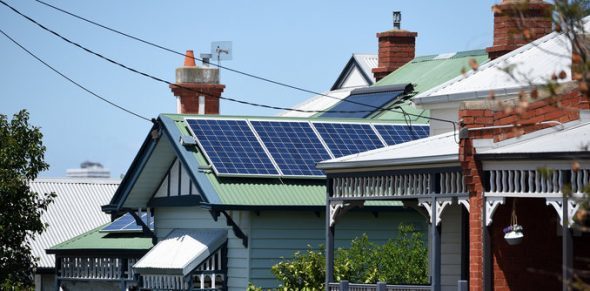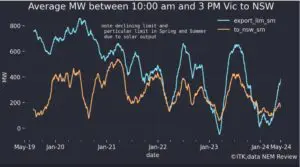This is the second of a series of articles produced by the fair value for distributed generation project. In the first article in this series we looked at the many values of distributed generation. In this article we look in more depth at one aspect of this value – the avoided use of transmission networks.
Around 6 per cent of the typical Australian residential electricity bill pays for the transmission network, but an increasing amount of energy comes from local generation which does not use this network. Changing the electricity market rules to reflect this reality could provide a bonus for solar owners and encourage a more cost effective electricity system.

Under the national electricity rules, the cost of building and maintaining the transmission network is passed on to retailers, who pass it on to customers. On average transmission network charges make up about 6%[1] of a residential electricity bill and distribution network charges about 40%[2].
Transmission charges are levied on all the electricity used, but an increasing proportion of electricity consumed comes from local generation (mainly household solar) which makes no use of the transmission network.
Customers should not pay transmission costs for the proportion of their energy that is sourced locally. These saving should be reflected in the price paid by retailers for energy fed into the distribution network by solar owners (and other distributed generators).
The benefits would be:
- Solar owners would receive a higher price for their exported energy.
- In the longer term, costs would be reduced for all consumers because a lower cost method of supplying energy would be supported.
How could it work?
There are several ways that electricity pricing rules could recognise the fact that local generation does not use the transmission infrastructure:
- A proposed rule change by the Total Environment Centre, the City of Sydney and the Property Council of Australia was submitted in 2015 to the Australian Energy Market Commission (AEMC). This proposed a mechanism called Local Generation Network Credits. Distributed generators would be paid a credit reflecting the fact that where energy is generated and consumed in the same area, the limited use of the grid should be reflected in lower costs. The AEMC rejected this proposal.
- Retailer could be given a credit for the proportion of the energy they buy from distributed generators connected to the distribution network (including solar energy exported by their customers). The electricity rules already provide for ‘avoided TUoS’ (Transmission Use of System) payments to large embedded generators that reduce the peak demand on the transmission network.
- The charge passed on to retailers for use of the transmission network could be based on the amount of electricity they buy from generators connected to the transmission network. (Currently the charge is based on the total amount of electricity they sell.) This would be analogous to the fact that retailers pay NEM fees based on the amount of electricity they buy from the NEM rather than the amount they sell.
The last two mechanisms (which have the same effect) would reduce network costs paid by retailers in proportion to the amount of exported solar energy they buy from their customers rather than from central generators. It is an accepted part of the setting of feed-in tariffs (FiTs) in Australia that they recognise savings to retailers and pass these savings to solar owners.
We believe the bulk of the savings on avoided use of the transmission network should be passed on to solar owners. This would increase the FiT by around 2c/kWh nationally. However a case could be made that a small proportion of these savings could be shared with retailers and networks to provide them with a motivation to implement this arrangement.
Would it be fair to other customers?
Some people argue that because the transmission networks are already built, reducing the transmission charges for some customers would just increase the costs for other customers. But forcing customers to pay transmission charges for all the energy they use irrespective of its source discourages the more efficient option of local generation.
Networks owners (state and private) do face a dilemma caused by the huge investments in existing infrastructure and the fact that electricity demand is static or falling. Potentially this can mean increased costs for users of the network if the same revenue is recouped from a reducing consumer base.
This assumes that networks have a ‘right’ to continue receiving the same payment for the service they provide even when the demand for the service drops. This assumption is embedded in existing rules for the national electricity market which allow networks to earn a guaranteed return on their ‘regulated asset base’ (RAB) irrespective of the amount of electricity they transport.
Distributed solar is often targeted as the cause of reducing demand (and hence increasing costs for non-solar customers) but in fact analysis by Hugh Saddler[3] showed that reduction in electricity demand between 2006 and 2013 was largely due to energy efficiency programs, structural change in the economy and the response of electricity consumers to higher electricity prices. Solar pv made a relatively small contribution, accounting for only 7% of the demand reduction.
The fact that networks are paid on the basis of their assets rather than on the service they provide distorts the operation of the market. It encourages networks to invest in network infrastructure, rather than seek out more efficient ways of meeting the energy demand. Despite the fact that demand for centrally generated electricity is fairly static, the national regulator has approved the expenditure of around $30bn on network upgrades over the next 5 years[4]. At a guaranteed rate of return of 6% this is $1.8bn annually that customers need to pay to networks.
The solution to increasing electricity costs is to find ways to reward the most efficient mechanisms for meeting electricity demand rather than to pay for infrastructure whether it is used or not. One approach would be a write-down of asset value, which is common in other industries faced with reduced demand or technological change which renders assets less valuable. A recent report[5] points out that “Australia’s electricity networks are extraordinarily profitable, realising many multiples of the returns being realised by Australia’s best performing ASX50 companies” and that revaluing their asset base to ‘maximum efficient’ values would reduce network prices paid by customers by 15-40%.
Changing the rules so that consumers do not pay long distance transmission charges for energy that is generated locally would be one small step towards a fairer and more cost effective electricity system.
- National average for transmission. States vary from 5-15%. See solarcitizens.org.au/fairprice for details.
- National average for distribution. States vary from 38-49%. See solarcitizens.org.au/fairprice for details.
- Power Down: Why is electricity consumption decreasing?, Hugh Saddler, The Australia Institute, Paper No 14, 18 Dec 2013http://www.tai.org.au/content/power-down
- AER State of the Energy Market 2015 p.75. https://www.aer.gov.au/publications/state-of-the-energy-market-reports
- Assets or Liabilities? The Need to Apply Fair Regulatory Values to Australia’s Electricity Networks, Hugh Grant, ResponseAbility 5th May 2016 http://euaa.com.au/entries/general/major-report-indicates-significant-scope-for-electricity-prices-to-fall
Jack Gilding is the Executive Officer of the Tasmanian Renewable Energy Alliance and was the project manager for the project “Research review and advocacy on the fair value of distributed generation”.
The project was funded by Energy Consumers Australia as part of its grants process for consumer advocacy projects and research projects for the benefit of consumers of electricity and natural gas. The views expressed in this document do not necessarily reflect the views of Energy Consumers Australia.










